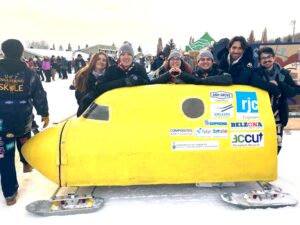
The University of Toronto’s Concrete Toboggan Team won first overall at this year’s 2025 Great Northern Concrete Toboggan Race (GNCTR).
Beating out 18 other universities involving over 400 engineering students, the entry came first overall supported by several key assessments and accumulating the top score at the illustrious competition. The team of 100, representing almost every department from U of T Engineering, had 30 travel to Montreal for this year’s efforts. The on-hill component of the event was held at Groupe Plein Air Terrebonne, a Montreal-area ski resort.

The Beatles-inspired “Yellow Submarine” entry nicknamed “Ringo”, though not the fastest down the hill, did very well with a solid performance by the team. “We were the second-fastest toboggan down the hill. We had excellent braking speed and a great steering design – on the steering race, we made it through all three of the slalom gates. We also placed for some design awards: second-best geometric profile for our skis, third place in superstructure design,” says co-captain Tobin Zheng (Year 4 MSE).
Co-captain Amélie Smithson (Year 4 MechE) relays the surprise of realizing the team’s winning final score, “Saturday night, the night of race day, they went through and announced all the results of each assessment – none of this had been released beforehand. I would say we were quite surprised, because we weren’t the fastest team down the hill, and we weren’t really expecting it at all. I think the team was very excited to find that out.”
Previous noticeable innovations for the team’s toboggan design included the addition of a carbon fibre shell, making it lightweight; this year’s iteration involved not using a chassis and several other, otherwise hidden, modifications.
“Ever since 2020, the T-Bog design has been slowly evolving. The reason they look similar is because we’ve kind of nailed the aerodynamic structure of the body. Although, functionally, the toboggans are not all the same; we change up the braking and steering system every year, as well as the concrete mix and the ski design. Those are things that are not the most observable, but they do develop and innovate,” Zheng shares.
Smithson adds, “One thing that does definitely change, even though it may look similar, is the fabrication process itself. Using different materials and molds, trying to figure out what’s the easiest and fastest way to make the design, so that it results in a very smooth design. There’s innovation every year.”
The co-captains provided shoutouts to CivMin’s Olga Perebatova, a Concrete Materials Technician, who was very helpful for concrete pours and testing, and to MIE’s Jeeth Anayat, in the MC78 Machine Shop, for his assistance with mechanical work.
WATCH: U of T CONCRETE TOBOGGAN IN ACTION
Founded in 1974, the GNCTR is held annually at various sites across Canada. It is the largest and longest-running undergraduate engineering competition in Canada. Representing a multidisciplinary challenge, teams construct a toboggan with a fully concrete running surface (usually skis), steering and braking systems, as well as a roll cage. Designs must weigh less than 350 lbs and accommodate five riders safely
U of T last won the GNCTR in 2020, shortly before the pandemic shutdown, with a Canada Post-inspired entry. The winning 2020 Concrete Toboggan is on display in the Myhal Centre lobby.
By Phill Snel